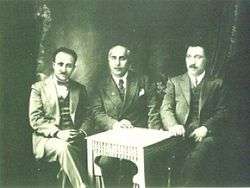Kamuran Alî Bedirxan
Kamuran Ali Bedirxan (Kurdish: Kamuran Alî Bedirxan ,کامەران بەدرخان,[1][2] born 21 August 1895 in Istanbul, Ottoman Empire; died 6 December 1978 in Paris) was a Kurdish politician, lawyer and writer.
Kamuran Alî Bedirxan | |
|---|---|
 Bedirxan brothers. Left to right: Kamiran (1895- 1978), Sureyya (1883-1938), Celadet (1895-1951). | |
| Born | 21 August 1895 Istanbul |
| Died | 6 December 1978 Paris |
| Occupation | Lecturer, Publisher |
| Language | Kurdish |
| Nationality | Kurdish |
| Subject | Kurds |
| Spouse | Nathalie d'Ossovetzky |
| Relatives | Bedirxan family |
Family
He came from the family of the Bedirxans, who for centuries, as autonomous vassals of the Ottomans, ruled the Principality of Bohtan with the capital Cizre . His grandfather Bedirxan Beg had rebelled against the Ottomans at the end of the 19th century and was deported to Istanbul after his defeat and family. Kamuran's father Emin Ali Bedirxan was politically active in the Kurdish movement and was the founder of the Kurdistan Teali Cemiyeti, in which Kamuran was also a member. His brother Celadet Ali Bedirxan was also politically active and the creator of the Latin Kurmanji alphabet.
Kamuran had been married to the Polish princess Nathalie d'Ossovetzky (who died in 1975) since 1954. d'Ossovetzky, who has been his student and later also secretary, was supportive of his writing.[3] The couple had no children.
Career
Kamuran attended the French Galatasaray High School in Istanbul. Between 1905 and 1908 his family had to leave the city because of a murder at the Istanbul prefects and lived in Isparta and Beirut . He later studied law at Istanbul University and worked as a lawyer. In 1918, he became a member of the Society for the Elevation of Kurdistan (Kurdistan Teali Cemiyeti), like others from his family. In 1919, Kamuran and his brother Celadet Bedirxan accompanied British officer Edward Noel in his travels through Iraq. Noel was assessing the possibility of the creation of an official nation of Kurdistan.[4]
Bedirxan was an opponent of Atatürk's independence movement and was ordered by the British government in Istanbul to go to a planned congress in 1919 in Sivas and arrest Mustafa Kemal Atatürk. He set off with several men, including his brother, the governor of Harput and the British officer Edward Noel, but the project failed.
Kamuran was an opponent of Kemalism and when the Republic of Turkey was proclaimed in 1923, he had already left the country to Germany.[5] He lived with his relatives in Munich where he studied law at the Ludwig Maximilians Universität and after followed up on his studies at the University of Leipzig from which he also graduated.[6] In 1927 he settled to Syria and worked as a lawyer in Beirut.[6] He also joined the organization Xoybûn and helped his brother with the publication of the Kurdish newspaper Hawar. In the thirties he stayed in Berlin and met the Iranian Karl Hadank. Between 1943 and 1946 Kamuran published the Kurdish and French-language magazine Roja Nû (en: New Day) in Beirut. The following years he lived in Germany and France. After Syria became independent in 1946, he moved to Paris [7]where he became a lecturer at the Institut national des langues et civilizations orientales (INALCO) in 1948.[8]
From 1960 he became the European spokesman for the Iraqi Kurds led by Mustafa Barzani. He established important contacts between the Kurds and Israel.[9] Israel saw the Kurds as a suitable means of weakening Iraq militarily and tying up the Iraqi army in northern Iraq. In 1970 he retired.
Kamuran died in 1978. He was posthumously appointed the co-founder of the Kurdish Institute of Paris. His works are kept in the Institute.[3]
Selected works
- Dilê qurên min. Ji giyanê bavê min - Kurdish poetry, 1923 Damascus
- Snow of Light - poem, 1935 Berlin
- Xwendina Kurdî, 1935, Damaskus
- Der Adler von Kurdistan, 1937, Berlin
- Memorandum on the situation of the Kurdes, 1948 Paris
- Le Kurde sans Peine's textbook, 1953 Paris
- Langue kurde, 2 volumes, 1953 Paris
Sources
- Hakan Özoğlu: Kurdish Notables and the Ottoman State: Evolving Identities, Competing Loyalties, and Shifting Boundaries . Suny Press, 2004. ISBN 0-7914-5993-4 .
- Text by Birgit Ammann about Kamuran Bedirkhan
References
- Malmîsanij : Cızira Botanlı Bedirhaniler ve Bedirhani Ailesi Derneği'nin Tutanakları , Publisher Avesta
- "Prince Dr Kamuran Ali Bedirxan". www.saradistribution.com. Retrieved 21 December 2019.
- "کامەران بەدرخان و ڕۆژنامەی" (in Kurdish). Retrieved 21 December 2019.
- Henning, Barbara (2018-04-03). Narratives of the History of the Ottoman-Kurdish Bedirhani Family in Imperial and Post-Imperial Contexts: Continuities and Changes. University of Bamberg Press. p. 375. ISBN 978-3-86309-551-2.
- "Jeladet Bedir Xan (1893-1951) | Kurdish Academy of Language". www.kurdishacademy.org. Retrieved 2017-09-06.
- Ersoy, Ahmet; Górny, Maciej; Kechriotis, Vangelis (2010). Modernism: Representations of National Culture. Central European University Press. ISBN 9789637326646.
- Henning, Barbara (2018), p.370
- Winter, Stefan (2006). "The other "Nahdah": The Bedirxand, the Mîllis and the tribal roots of Kurdish Nationalism in Syria". Oriente Moderno. 25 (86) (3): 464. ISSN 0030-5472.
- "Knowledge, ideology and power. Deconstructing Kurdish Studies". 2008-01-02. Archived from the original on 2008-01-02. Retrieved 2020-05-07.
- "From Damascus Street to Kurdistan | Alliance for Kurdish Rights". Retrieved 2017-09-06.
External links
- Photo of Kamuran Bedirxan
- Pariste bir Kürt Prensi Kamuran Bedirhan , article by Soner Yalçın from the Hürriyet of 25 October 2009